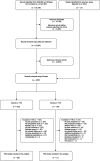What proportion of people have long-term pain after total hip or knee replacement? An update of a systematic review and meta-analysis
- PMID: 40398950
- PMCID: PMC12096998
- DOI: 10.1136/bmjopen-2024-088975
What proportion of people have long-term pain after total hip or knee replacement? An update of a systematic review and meta-analysis
Abstract
Objectives: To update our previous systematic review to synthesise latest data on the prevalence of long-term pain in patients who underwent total hip replacement (THR) or total knee replacement (TKR). We aim to describe the prevalence estimates and trends in this review.
Design: Systematic review and meta-analysis.
Data sources: Update searches were conducted in MEDLINE and Embase databases from 1 January 2011 to 17 February 2024. Citation tracking was used to identify additional studies.
Eligibility criteria: We included prospective cohort studies reporting long-term pain after THR or TKR at 3, 6, 12 and 24 months postoperative.
Data extraction and synthesis: Two reviewers independently identified studies as eligible. One reviewer conducted data extraction, checked by a second reviewer. The risk of bias assessment was performed using Hoy's checklist. Bayesian, random-effects meta-analysis was used to synthesise the results.
Results: For TKR, 68 studies with 89 time points, including 598 498 patients, were included. Multivariate meta-analysis showed a general decrease in pain proportions over time: 21.9% (95% CrI 15.6% to 29.4%) at 3 months, 14.1% (10.9% to 17.9%) at 6 months, 12.6% (9.9% to 15.9%) at 12 months and 14.6% (9.5% to 22.4%) at 24 months. Considerable heterogeneity, unrelated to examined moderators, was indicated by substantial prediction intervals in the univariate models. Substantial loss to follow-up and risk of bias led to low confidence in the results. For THR, only 11 studies were included, so it was not possible to describe the trend. Univariate meta-analysis estimated 13.8% (8.5% to 20.1%) and 13.7% (4.8% to 31.0%) of patients experiencing long-term pain 6 and 12 months after THR, respectively, though concerns in risk of bias results reduced confidence in these findings.
Conclusions: Our review suggests that approximately 22% of patients report pain 3 months post-TKR, with 12%-15% experiencing long-term pain up to 2 years. At least 14% report pain 6-12 months after THR. Given the prevalence of chronic postsurgical pain, implementing existing and developing new preventive and management strategies is crucial for optimal patient outcomes.
Prospero registration number: CRD42023475498.
Keywords: Chronic Pain; Hip; Knee; Meta-Analysis; ORTHOPAEDIC & TRAUMA SURGERY; Systematic Review.
© Author(s) (or their employer(s)) 2025. Re-use permitted under CC BY. Published by BMJ Group.
Conflict of interest statement
Competing interests: None declared.
Figures




Similar articles
-
Physiotherapy rehabilitation after total knee or hip replacement: an evidence-based analysis.Ont Health Technol Assess Ser. 2005;5(8):1-91. Epub 2005 Jun 1. Ont Health Technol Assess Ser. 2005. PMID: 23074477 Free PMC article.
-
Evaluating methodological quality of prognostic prediction models on patient reported outcome measurements after total hip replacement and total knee replacement surgery: a systematic review protocol.Syst Rev. 2022 Aug 10;11(1):165. doi: 10.1186/s13643-022-02039-7. Syst Rev. 2022. PMID: 35948989 Free PMC article.
-
Folic acid supplementation and malaria susceptibility and severity among people taking antifolate antimalarial drugs in endemic areas.Cochrane Database Syst Rev. 2022 Feb 1;2(2022):CD014217. doi: 10.1002/14651858.CD014217. Cochrane Database Syst Rev. 2022. PMID: 36321557 Free PMC article.
-
A cross-sectional survey on prevalence and risk factors for persistent postsurgical pain 1 year after total hip and knee replacement.Reg Anesth Pain Med. 2012 Jul-Aug;37(4):415-22. doi: 10.1097/AAP.0b013e318251b688. Reg Anesth Pain Med. 2012. PMID: 22660483
-
Clinical Effectiveness and Safety of Aspirin for Venous Thromboembolism Prophylaxis After Total Hip and Knee Replacement: A Systematic Review and Meta-analysis of Randomized Clinical Trials.JAMA Intern Med. 2020 Mar 1;180(3):376-384. doi: 10.1001/jamainternmed.2019.6108. JAMA Intern Med. 2020. PMID: 32011647 Free PMC article.
Cited by
-
Knee Osteoarthritis Diagnosis: Future and Perspectives.Biomedicines. 2025 Jul 4;13(7):1644. doi: 10.3390/biomedicines13071644. Biomedicines. 2025. PMID: 40722715 Free PMC article. Review.
-
Facilitating translation of trial findings into NHS practice : case study of the Support and Treatment After Replacement (STAR) care pathway.Bone Jt Open. 2025 Jun 5;6(6):644-650. doi: 10.1302/2633-1462.66.BJO-2024-0043.R1. Bone Jt Open. 2025. PMID: 40467060 Free PMC article.
References
-
- NICE Joint replacement (primary): hip, knee and shoulder (2020) NICE guideline NG157. 2020 - PubMed
-
- NJR Service Centre . Hemel Hempstead: 2023. National joint registry. 20th annual report.
-
- Public Health Scotland . Edinburgh: 2023. Scottish arthroplasty project national report 2023.
Publication types
MeSH terms
LinkOut - more resources
Full Text Sources
Medical
